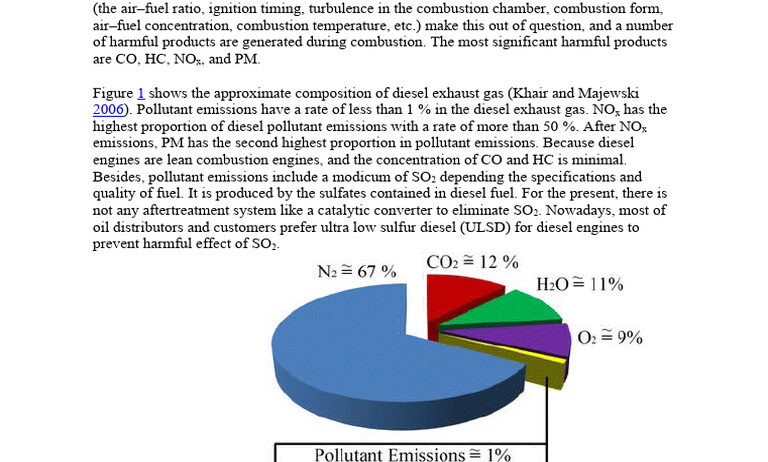The proliferation of diesel engines, particularly in the transport and industrial sectors, has long been a double-edged sword. While these engines are renowned for their fuel efficiency and durability, they also emit nitrogen oxides (NOx), a group of highly reactive gases that have significant implications for both air quality and climate change. But do diesel NOx emissions play a substantial role in global warming? This inquiry not only illuminates the multifaceted relationship between air pollutants and climate dynamics but also invites us to consider a challenging proposition: could an increased focus on reducing NOx emissions serve as a pivotal strategy in combatting global warming?
Nitrogen oxides are primarily produced during the combustion of fossil fuels, especially at high temperatures. Diesel engines, in particular, operate under high compression, which enhances their efficiency but also results in the release of NOx. Once these gases are in the atmosphere, they undergo a series of reactions that can lead to the formation of ground-level ozone, a potent greenhouse gas. The question arises: is the contribution of NOx emissions to global warming significant enough to warrant urgent policy intervention?
To unpack this issue, it is essential to understand the mechanics of NOx. Comprising nitric oxide (NO) and nitrogen dioxide (NO2), these gases have distinct roles in atmospheric chemistry. NO, for example, can quickly react with oxygen to form NO2, which then participates in further reactions that produce ozone. Ground-level ozone, while beneficial in the upper atmosphere for blocking harmful UV radiation, becomes a detrimental pollutant at lower altitudes. Its presence enhances the greenhouse effect, trapping heat and exacerbating global warming.
Moreover, the interaction between NOx and other pollutants complicates the picture further. For instance, NOx emissions contribute to the formation of particulate matter, which has been shown to influence cloud formation and precipitation patterns. This interplay could potentially lead to altered weather events, with implications ranging from droughts to intense storms, further complicating the global warming narrative.
The U.S. Environmental Protection Agency (EPA) has been at the forefront of monitoring and regulating emissions from diesel engines. The agency has acknowledged the significant health and environmental risks posed by NOx, issuing regulations that aim to substantially reduce these emissions. Initiatives such as the Clean Air Act have sought to mitigate the health impacts of air pollution, but could these regulations also yield benefits for climate change mitigation? By limiting NOx emissions, the EPA posits that we can indirectly reduce the formation of ground-level ozone and, consequently, its warming effects.
However, addressing diesel NOx emissions prompts another question. How do we balance the benefits of diesel fuel usage against the environmental costs? Diesel engines are lauded for their efficiency, especially in heavy-duty applications where they outperform gasoline engines in fuel economy. This efficiency can lead to reductions in carbon dioxide (CO2) emissions per unit of energy produced. Yet, if we weigh CO2 reductions against the adverse effects of NOx emissions, the environmental scales might tip unfavorably. It begs the consideration of whether we should continue to endorse diesel technology, or transition to alternative fuel sources that are less harmful to the atmosphere.
Additionally, technological advancements are critical in this discourse. Innovations such as selective catalytic reduction (SCR) and diesel particulate filters (DPF) have made it possible to significantly curtail NOx emissions from diesel engines. The implementation of these technologies could be instrumental not just in adhering to regulatory standards, but in contributing positively to global warming mitigation efforts. Could it be that embracing and investing in such technologies provides an avenue for reducing the warming potential of NOx while still leveraging the benefits of diesel engines?
As with any environmental challenge, individual action plays a role. Consumers can contribute to the reduction of NOx emissions by making informed choices regarding vehicle purchases and advocating for cleaner technologies. Further, there is a growing movement towards electrification, with many stakeholders in the transportation sector opting for electric or hybrid vehicles that emit little to no NOx. But will these consumer behaviors be enough to make a significant impact, or do policy changes need to act as a catalyst?
In contemplating the role of diesel NOx emissions in global warming, we must also consider the global context. Developing nations that rely heavily on diesel for transportation and industry may not have the same regulatory frameworks as more developed regions. Thus, a comprehensive approach to reducing diesel NOx emissions must include international cooperation and support systems. Preventative measures and economic incentives can foster a transition towards cleaner technologies in these regions.
In summary, the intersection of diesel NOx emissions and global warming is multifaceted and warrants a comprehensive examination. The EPA’s efforts to regulate these emissions highlight the potential for substantial environmental benefits, yet the continued reliance on diesel technology poses a challenge. As technological advancements evolve and consumer habits shift, the opportunity remains for a transformative approach to emissions management. The question persists: can society rise to meet this challenge, adopting innovative strategies while reducing reliance on pollutive practices? The answer holds the key to a sustainable future amidst the escalating climate crisis.








